



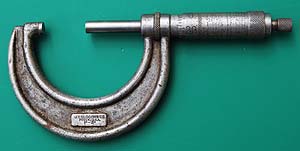
J T Slocomb Co, Providence, Rhode Island, USA
1” - 2” micrometer.
1” -
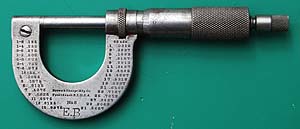
Brown & Sharpe Mfg. Co., Providence, Rhode Island, USA, No 8
0 - 1” micrometer
Patented Nov. 6th 1894 and Dec. 30th 1902.
It has a mahogany case.
0 -
It has a mahogany case.
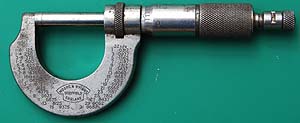
Moore & Wright, Sheffield, England, No 961S
0 - 1” micrometer
It has an adjusting spanner.
Moore & Wright was founded in 1908.
0 -
Moore & Wright was founded in 1908.
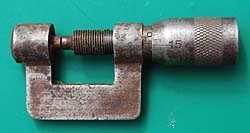
0 - 1/2” micrometer by an unknown maker
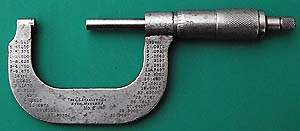
L S Starrett, Atholl, Massachusetts, No. 2 micrometer, 1 - 2”
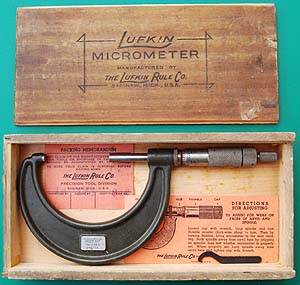
Lufkin 2”-3” micrometer dating from the mid-20th century. Although the case has some damage the micrometer itself still has some of its original preservative grease on it suggesting that it has hardly been used. It also has its adjustment instructions and key, and its packing slip.
The Lufkin Rule Co., Saginaw, Michigan, USA
The Lufkin Rule Co., Saginaw, Michigan, USA
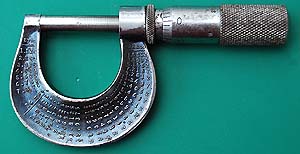
Reed No 701 0-1” micrometer made by the Reed Small Tool Works, Worcester, Mass., USA. It has its original card box. The front of the frame is marked with the decimal equivalents of 1/8ths, 1/16ths and 1/32nds and the back with 1/64ths.
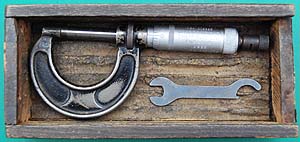
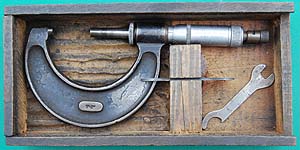
Moore & Wright no. 965 (0 - 1”) and no. 966 (1 - 2”) micrometers in original boxes with spanners. Much used but well cared for.
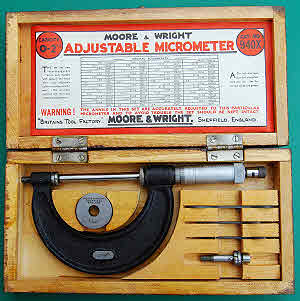
Moore & Wright 940X 0 - 2” adjustable micrometer. Although it possibly dates from the 1930s (it is in the 1936 catalogue) it is in near mint condition with both anvils, the one inch circular standard, and its tools as well as instructions and other leaflets. There were also larger sets with more lengths of anvil to cover a greater range.
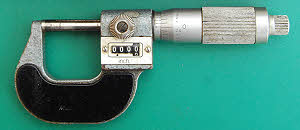
Mitutoyo digit 0-1” micrometer. This is a mechanical digital micrometer. It is complete with instructions and case.
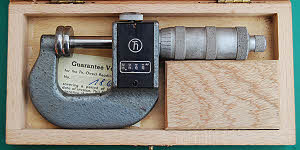
Digital (mechanical) 0-1” micrometer by TH of Germany with its case and guarantee certificate. This is a special micrometer for measuring soft materials such as paper and rubber - hence the large diameter anvils.
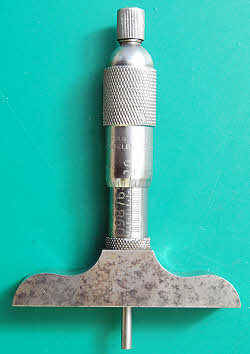
Millers Falls Co., Greenfield, Massachusetts, USA No 31 depth micrometer (0-1”).
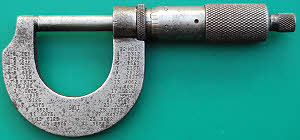
Reed No 901 0-1” micrometer made by the Reed Small Tool Works, Worcester, Mass., USA. The front of the frame is marked with the decimal equivalents of 1/8ths, 1/16ths and 1/32nds and the back with 1/64ths.
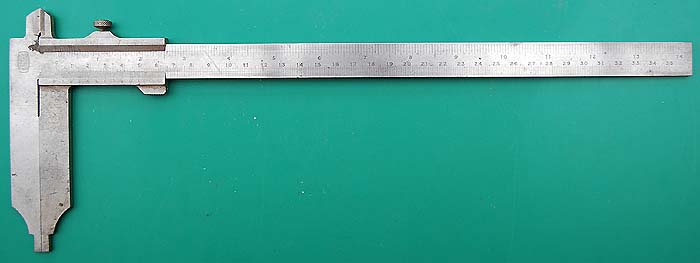
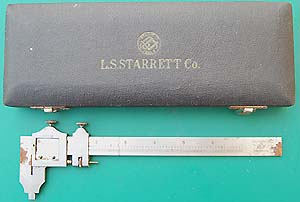
7 inch steel vernier calliper by the L S Starrett Co, Athol, Massachusetts, USA. No. 122.
It is graduated on the front for outside measurements and on the back for inside measurements. The verniers read to 1/1000”.
It is graduated on the front for outside measurements and on the back for inside measurements. The verniers read to 1/1000”.
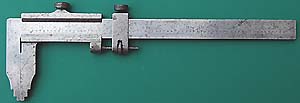
7 inch steel vernier calliper marked ‘Original Deckel’ and ‘Foreign’ on the reverse, almost certainly made in Germany. It has 7 inch by 40ths and 18 cm by 1 mm scales and the verniers read to 1/1000 in and 0.1 mm. For inside measurements the tips are marked 1/8” and 5 mm. These amounts doubled have to be added to inside measurements. Serial no. 8583.
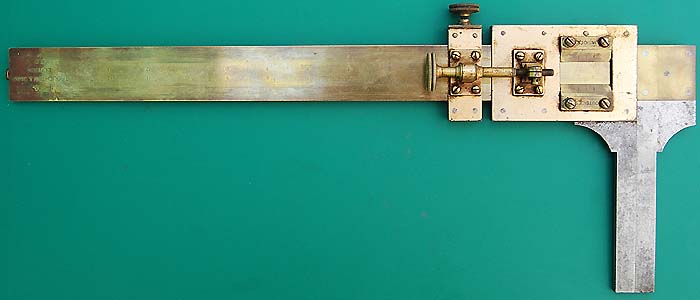
14” inside and outside Vernier calliper signed ‘Troughton & Simms London No. 335 W↑D’ made of brass and steel. The upper scale and vernier are for inside measurements and the lower ones for outside. Probably late 19th century. It has a fitted mahogany case. Troughton & Simms were scientific instrument makers rather than engineering tool manufacturers and the construction reflects this.

Satin chrome finished 21cm vernier with inch and metric scales made by Benson Verniers of Bradford. It has a black leatherette covered, blue velvet lined case.
Steel vernier calliper by Mauser. Germany. Graduated to 14 inches by sixteenths on the upper edge and 350 mm by one mm on the lower edge. The inch vernier reads to 1/132 inches and the metric vernier to an order finer 0.02mm.

Benson Verniers, Bradford 9” vernier calliper rule, mid 20th century. This is an earlier model than the one shown above. It has a black leatherette covered, blue velvet lined case.
 Chesterman no. 770/1 vernier calliper for inside and outside measurement. It has inch and metric scales with a vernier resolution of 1/1000” and 1/50 mm respectively. It has a black leatherette covered, blue velvet lined case in which there is also a one inch circular standard. Probably 1950s. Maximum measurement with vernier = 6”.
Chesterman no. 770/1 vernier calliper for inside and outside measurement. It has inch and metric scales with a vernier resolution of 1/1000” and 1/50 mm respectively. It has a black leatherette covered, blue velvet lined case in which there is also a one inch circular standard. Probably 1950s. Maximum measurement with vernier = 6”.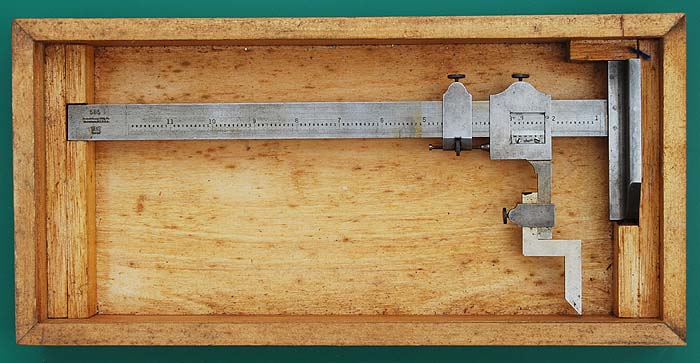
Brown & Sharpe Manufacturing Co, Providence, Rhode Island, USA , 585 vernier height gauge reading to 1/1000”
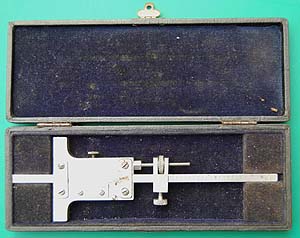
UPT, British made, vernier depth gauge and fitted case
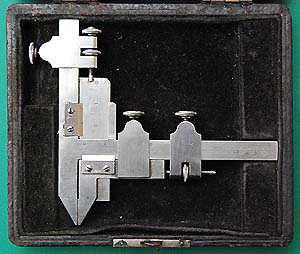
Brown & Sharpe, Providence, Rhode Island gear tooth vernier calliper. The upper vernier is used to set the depth at which the width of the gear tooth will be measured by the vernier calliper.
It has a leather case lined with black velvet.
It has a leather case lined with black velvet.
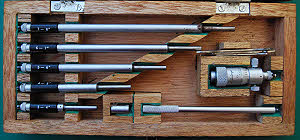
Mitutoyo internal micrometer. The range of interchangeable anvils allow dimensions from 2 to 8 inches to be measured, The 2 to 3 inch one is fitted to the micrometer body in the case. 1960s. Purchased for use in my workshop and still in use when required.
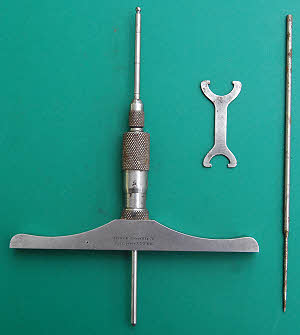
Brown & Sharpe Mfg Co, Providence, RI, USA adjustable depth micrometer patented Jan 11, 1898. The micrometer is a half inch type reading to 1/1000 in. The anvil is adjustable and marked in steps of 1/2 in. It is locked by the screw collet It is complete with its spanner for removing the micrometer assembly from the bridge and a robust, slide-top, wooden box. The spare. finely pointed, anvil has no half inch dividing so may have been craftsman made. The bridge is 4 inches wide.
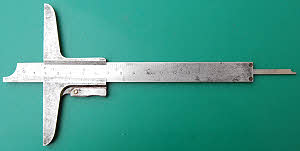
ABR Almkvist & Co, Eskiltuna, Sweden vernier depth gauge graduated for 6 inches and 16cm. Vernier reads to 0.1mm and 1/132 in. For large holes one end is used and for small holes the other. The bridge is 4.5in wide.
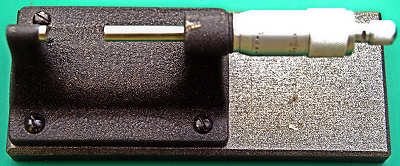
Moore & Wright No 178/2 bench micrometer intended for inspection rooms, 1” to 2” capacity. Complete with black wooden box, adjusting key and instruction leaflet. Probably dates from the 1950s.
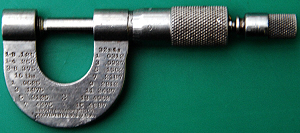
Brown & Sharpe Providence Rhode Island 0 to 1/2 inch micrometer. On the front face it has decimal equivalents of eighths, sixteenths and thirtyseconds and on the rear face of sixtyfourths.
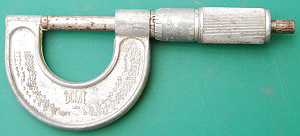
Die Casting Machine Tools, made in England, 0-
| Early Sets |
| Traditional Sets |
| Later Sets |
| Major Makers |
| Instruments |
| Miscellanea |
| W F Stanley |
| A G Thornton |
| W H Harling |
| Elliott Bros |
| J Halden |
| Riefler |
| E O Richter |
| Kern, Aarau |
| Keuffel & Esser |
| Compasses |
| Pocket compasses |
| Beam compasses |
| Dividers |
| Proportional dividers |
| Pens |
| Pencils |
| Rules |
| Protractors |
| Squares |
| Parallels |
| Pantographs |
| Sectors |
| Planimeters |
| Map Measurers |
| Miscellaneous |
| Materials Used |
| Who made them |
| Who made these |
| Addiator |
| Addimult |
| Other German |
| USA |
| Miscellaneous |
| Microscopes |
| Barometers |
| Hydrometers & Scales |
| Pedometers |
| Surveying Instruments |
| Other instruments |
| Workshop Measuring Tools |
| Catalogues & Brochures |
| Micrometers & Verniers |
| Engineering rules and gauges |
| Wood rules & calipers |
| Dial gauges & miscellaneous |